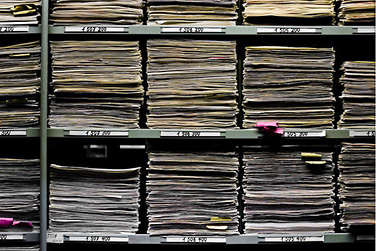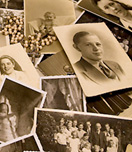News
Powerful portfolio of Nazi archives coming to UB

This photo by Richard Ehrlich of the Nazi Archive, International Tracing Service, Bad Arolsen, Germany, is among those that will be on exhibit at UB.
In addition to the massive atrocity of the Holocaust and the individual horrors that attended it, most people have no idea of the extent of the weirdly obsessive record-keeping practices of the Nazis bureaucracy, whose millions of mundane and detailed materials present excruciating and undeniable evidence of its terrible crimes.
The existence of these records, documented by noted photographer Richard Ehrlich, not only takes our understanding of the Holocaust to an entirely different, and most uncomfortable, level, but also explicitly and powerfully challenges Holocaust denial.
The UB Art Gallery in the Center for the Arts, North Campus, will present this evidence in the stunning exhibit “The Holocaust Archive Revealed: Bad Arolsen through the Lens of Richard Ehrlich,” on view April 21 through June 20.
The exhibition, which is free and open to the public, will be in the gallery’s second-floor exhibition space. A public reception for Ehrlich will be held in the gallery, beginning at 6:45 p.m. on April 21.
The exhibition was made possible through support from UB alumnus Wayne S. Blank, B.A. ’66, a member of the College of Arts and Sciences Dean’s Advisory Council and president of Bergamot Station in Santa Monica, Southern California's largest art gallery complex and cultural center, and of the Shoshana Wayne Gallery.
The exhibition will be mounted in conjunction with a lecture that day, “The Holocaust and Art: Differing Approaches,” by artist Marty J. Kalb, Ohio Wesleyan University professor emeritus, whose “Holocaust Series” documents what he calls “the industrialization of murder by a modern government.” Click here to read a story about Kalb’s lecture.
Sandra Firmin. UB Art Gallery curator, explains that the subject of Ehrlich’s photographs is the International Tracing Service (ITS) archive in Bad Arolsen, Germany, which encompasses more than 16 miles of records and artifacts housed in six buildings, one a former SS barracks.
She says the archives themselves and Ehrlich’s photos, taken shortly after the ITS opened to the public in 2007, reveal with excruciating exactitude the Nazi campaign to murder 17 million people and eradicate European Jewry and other “undesirable minorities.”
Through Ehrlich’s lens, the viewer encounters the chilling precision and obsessive mentality of the Nazi bureaucracy. Today, at a time of resurging Holocaust denial, these thousands of folders, storage boxes, stacks of papers and ledgers—normally the mundane paraphernalia of record keeping—provide painful and irrefutable evidence of history’s most unimaginable crime.
The exhibition comprises 28 panels featuring photographs taken in the ITS, accompanied by text detailing the varied contents of the archives, which were collected from a number of sources, including the Gestapo, ghettos, prison camps and other agencies of Nazi authority.
Firmin points out that among the many individual documents depicted are the original “Schindler’s list,” a transport order to Bergen Belsen that includes the name of Anne Frank and an invitation from Gestapo chief Reinhard Heydrich to a brunch meeting to discuss “a total solution to the Jewish question in Europe.”
“Ehrlich’s photographs give us entries in the Buchenwald prisoner logs and death books,” she says. “They show us medical records that count lice removed from prisoners. They permit us to absorb the sheer magnitude of countless record-lined shelves and to witness intimate details of people’s daily lives told through photographs and personal possessions.”
The 50 million ITS documents have played an important role in historical research, family reunification, refugee services and in tracing the fates of countless individuals.


Reader Comments